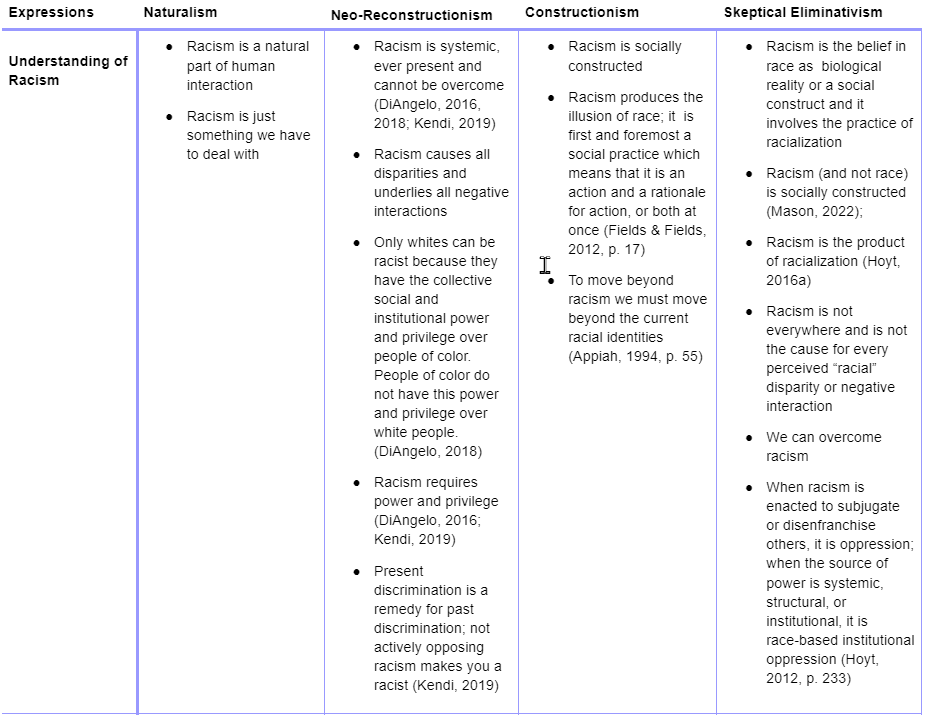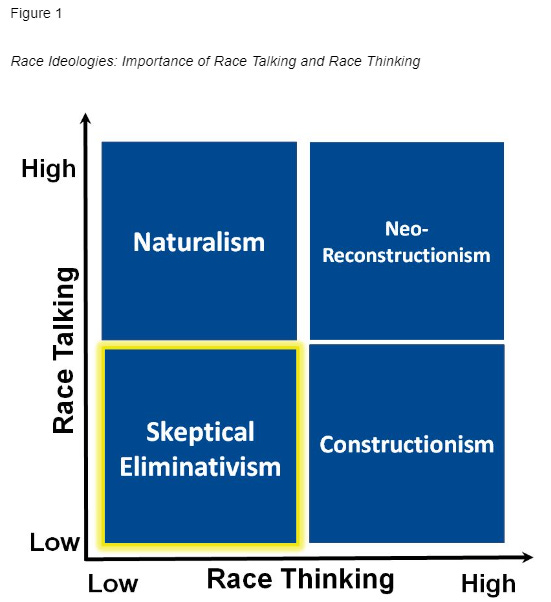Race / Racism
RACE IDEOLOGY-IN-PRACTICE
Racial equity in American learning environments
Tabia Lee, EdD
NOTE: Journal of Free Black Thought and Abolishing Race(ism) are co-posting this article together. Click here to read the article at Abolishing Race(ism).
As we continue to ride the crest of third wave “anti-racist reckoning” in America, it becomes ever more important to raise conscious awareness about the various race ideologies that are in tacit, explicit, intentional, or complicit operation in learning environments at all levels and that underlie teacher training programs, socialization, and professionalism. Race ideologies inform the ways of understanding race in the world, or the mental frameworks that teachers embody and enact and that are wittingly or unwittingly made observable in learning environments as manifested in curriculum and instruction and also teacher actions and interactions with colleagues, students, and community members. And yet, race ideologies remain largely undisclosed and undiscussed even as they are made more visible and impactful in education and across society.
This essay outlines some of the most common race ideologies that underlie teacher assumptions about and understanding of race, racism, and racial equity that in turn inform pedagogical and curricular choices in American learning environments. My intent is to illuminate some of the understandings that become possible when we start to unlearn some of the lies we have been taught through the dominant naturalist, neo-reconstructionist, and constructionist race ideologies and instead start to lean into understandings of race that are informed by skeptical eliminativist ideologies such as the Theory of Racelessness as articulated by Dr. Sheena Mason (2022) . Accordingly, at times I use a couple of linguistic markers informed by Dr. Mason’s work to denote an emergent shift in race talking and thinking that may be unfamiliar to the vast majority of teacher educators, diversity and equity consultants, and staff professional development leaders in California and nationwide even in highly regarded and so-called progressive teaching and learning spaces. I use the term race(ism) to denote that race and racism are intertwined and to signify that race is a creation of racism; I use the term raci(al/ st) to affirm an understanding that engagement in thinking or speaking of humanity in racialized terms is a reflection of the unique ways that we have been indoctrinated since birth to (mis)understand our humanity and also to form us into more obedient and unquestioning proponents of the racism that once again and most ironically prevails in far too many American learning environments, at least for now.
American education has a race(ist) problem; the American schooling system and our society at large were set up to promote and socialize folks into raci(al/ st) ideologies. Well documented pushes for racial equality during the first and second waves of anti-racism attempted to right those wrongs in our schools and in our communities. However, in recent years neo-reconstructionist race(ist) hustlers have become dominant in educational discourse and beyond, threatening to push us backwards and further into the deeps of racial strife and division with a hyper-focus redefining racism as systemic and a promotion of equity over equality that are advancing under third wave anti-racist banners which some argue have done more harm than good (McWhorter, 2021). Under the banner of Diversity, Equity, and Inclusion (DEI) efforts, in many learning environments a neo-reconstructionist race(ist) orthodoxy has emerged that actively works to suppress and exclude alternative frameworks, methods, ways and means for dealing with American education's race(ist) problem.
Presently in many American schools, third-wave neo-reconstructionist ideologies of racial equity that are rooted in faulty remakings and re-interpretations of race and racism are fomenting perpetual race(ist) struggle and are dangerously directing the scope of mainstream educational research, discourse, and practice. Given that the vast majority of racial equity frameworks remain largely rooted in deterministic, reductive, and/or explanatory understandings of race(ism), skeptical eliminativist offerings like the Theory of Racelessness (2022) and Race Transcendence (2016) emerge as frameworks with practical, moral, and ethical utility that are particularly compelling in light of the persistent hyper-emphasis on disaggregation of racialized data in American elementary, secondary, and post-secondary schools. Make no mistake, the focus on raci(al/ st) data is the architecture and part of the toolkit of American race(ist) indoctrination and nothing more; specifically, the educational accountability systems in America were designed to promote, exploit, and emphasize the failure of American public schools (Lee, 2009). The deprofessionalization of teachers that went along with educational accountability systems worked to create and bring up an entire generation of American teachers that largely unquestioningly followed scripted curricula and had processes for teaching and learning handed down to them by experts; the Craft of teaching was outsourced and now race(ist) hustlers in the form of DEI consultants, senior leaders, and researchers are taking their hand at telling teachers what they should do in their classrooms to help fix American education’s race(ist) problem.
The urgent adoption of equity policies during this season of raci(al/ st) reckoning reflects the deep flaws in the proposed solutions to the race(ism) problem and the deeply flawed conceptual and pedagogical tools that are in use and promoted in learning environments that embrace a neo-reconstructionist understanding of race(ism) come to light more and more each day (Californians for Equal Rights Foundation, 2021; Free Black Thought, 2022; Legal Insurrection Foundation, 2022; Parents Defending Education, 2021). Especially as teachers at all levels are now being mandated to look at racialized student achievement data, to examine their teaching through neo-reconstructionist raci(al/ st) lenses, to employ aligned pedagogical tools and practices, and to support and advance aligned policies.
For example, the California Community College system is the largest higher education system in the United States and race(ist) neo-reconstructionist pedagogies and policies now unquestioningly and uncritically rule the roost while anti-racism writ large is co-opted to only represent neo-reconstructionist viewpoints (see Hotep Consultants, 2022). Sadly, groups that used to promote faculty viewpoint diversity and protect faculty academic freedom seemingly have aligned solely with faculty member rights to promote race(ist) neo-reconstructionist visions of anti-racism (Academic Senate for California Community Colleges, 2020; Faculty Association for California Community Colleges, 2022); while notably, some like me argue that the freedom to teach from a neo-reconstructionist lens was never under threat in the State of California to begin with. In practice, this means that an individual California Community College faculty member’s deviation from, questioning, or dissent about the prevailing race(ist) neo-reconstructionist fundamentalist orthodoxy opens them up to vicious slander, libel, and ostracization – in such a climate, absolute compliance with the new authoritarian order is veritably guaranteed and opportunities for diverse viewpoints to be expressed are crushed and silenced at every turn (see Foothill De Anza Community College District Board of Trustees, 2022).
At the macro-level, perhaps opportunities for more balanced conversations that include emergent and heterodox race ideologies right along with the others we have accepted largely without question may prove particularly worthwhile. Indeed, it is most pitiful and strange for teachers and students alike that the present push for neo-reconstructionist visions of equity in American education requires a maniacal focus on racialization of all people and things that is often rooted in dubious expectations and unfair responsibilities on educators alone to manifest equality of educational outcomes. Table 1 is a brief and by no means comprehensive representation of some of the ways that race ideologies are presently expressed in American learning environments. Notably, while there may be differences in how race naturalists, neo-reconstructionists, and constructionists view and understand race and racism, there is significant overlap in their understanding and use of the aligned pedagogical practices, concepts, and tools that are being employed nationwide at all levels during the present third-wave revival of race(ism).
Unfortunately, the activism entrenched, race(ist) pedagogies that are becoming prevalent in American learning environments from preschool through graduate school are not as well versed in terms of developmental appropriateness and pedagogical fit; for example, sadly in some schools first and second graders are being categorized into oppressor and victim groups and told to accept that their immutable racialized characteristics will determine their life fate and paths. As parents and community members become more informed about race ideologies; their questions about the ideologies in practice in students’ learning environments are rising and it is hoped that this essay gives rise to even more questions and inquiries.
Given that race(ist) hustlers have blossomed their profits since the neo-reconstructionist raci(al/ st) reckoning began in American schools and society at-large, it is important to discern and comprehend which race ideologies are being promoted when the question of transforming pedagogy for raci(al/ st) equity in American school is raised and when solutions or ways forward are pushed. Contrary to popular understanding, there are innumerable race ideologies that have been used, are in use, and could be used should we be interested in moving ahead more meaningfully toward the professed goals of diversity, equity, and inclusion. However, this essay focused on three of the most commonly found and one of the emergent race ideologies that knowingly or unknowingly inform organizational approaches to racial equity and teacher race ideology-in-practice. It is also important to note that each teacher has a potentially complex interaction with and understanding of race(ism) in America and so may express, embody, or enact a variety and/or combination of these race ideologies in varied contexts.
Naming and articulating the race ideologies in use when individual teachers, DEI professionals, and policy makers talk about racial equity will help us all to better understand the approaches to race and racism that are being promoted when these things are mentioned. Figure 1 visualizes the importance and centrality of race talking and race thinking under the various ideologies of race that are employed in American learning environments; environments where race talking and race thinking are low, or rooted in skeptical eliminativist frameworks such as the Theory of Racelessness (Mason, 2022) and Race Transcendence (Hoyt, 2016) have a greater potential for transformative and humanistic learning. This is not to say education is colorblind or that culture disappears from the learning environment; instead, culture and ethnicity may be elevated when pro-human approaches are embodied and enacted instead of pro-racism approaches that require individuals to tick a box and stay in it while acting out and existing within the limitations of the privileges and oppressions that are associated with each of the assigned or ascribed racialized categories. Figure 2 visualizes the reification of race and racism in the various ideologies of race. The actions of individual educators impact not only the students in their learning environments, but their schools as collectives and in turn their societies as a whole; when students are engaged in learning processes that emphasize the reification of race and racism we become a world more locked into the present struggles that occupy our time and focus and seem to be without end or hope especially because they are so often discovered to be rooted in deterministic, neo-reconstructionist frameworks.
As we look to move ahead toward visions of racial equity in American schools, the race ideologies that are in use must become better articulated, understood, and more explicitly known by the teachers and educational leaders that are engaging with and promoting these things through their DEI work; it is particularly important to note a critical examination of the pedagogical concepts, tools, and practices that are being advanced are examined for developmental and age appropriateness in addition to determining if they align with the professed views of race, racism, and racial equity that are espoused in the learning environment’s organizational documents and practices. It is also important that individual teachers consider how race ideologies are engaged in at the micro- and macro- levels in their learning environments. Teachers that uncritically adopt and implement pedagogical practices without knowing their roots may experience or promote adverse impacts on the lives of students and thereby communities; notably, in reconstructionist bastions with long histories of social justice work that are presently celebrating their dominance from the elementary school to the graduate school in America, teaching and learning practices that are rooted in race(ism) have not bettered the lives of students even as intentional race(ist) neo-reconstructionist teaching has purportedly sought to empower and uplift.
Racial equity is not a neutral term and yet we hear it everywhere these days; it is a term loaded with ideological understandings of race, racism, and equity. If American learning environments remain sincerely committed to the advancement of critical thinking, a deeper understanding of the ramifications of each approach to racial equity along with exposure to the benefits of awareness about the diverse ways of thinking about race and racism is imperative because each of the race ideologies reifies race and racism and promotes race talking and race thinking in different ways. For example, in many California schools neo-reconstructionist approaches to race(ism) are dominating and the result is that there is a hyperfocus on race talking and race thinking focused activism that promotes the reification of race and racism as a zero sum game; teachers that resist these approaches or that merely raise questions about them are being cast out and pushed out in the name of advancing a commitment to neo-reconstructionist anti-racism which does not tolerate alternative viewpoints and views any alternate understandings of human existence as problematic.
Such absolutism is toxic to the core, and people are growing weary of the conformist cultures that are being produced under third-wave anti-racist banners and alarmed at the effects of the harmful concepts and pedagogies that are being used to advance them. This is why the emergence of skeptical eliminativist frameworks such as the Theory of Racelessness (Mason, 2022) and Race Transcendence (Hoyt, 2016a) are hopeful and helpful resources for the much anticipated next waves of anti-racist work… rays of light that provide methodological and pedagogical ways through that de-emphasize race talking and race thinking and work to abolish rather than reify race and racism as meaningful concepts in American teaching and learning environments – helping us develop a better understanding of where we have been and where we are now and providing teachers and people in general with the tools and understandings that are needed to move beyond the now obvious trappings of neo-reconstructionist anti-racist race(ism). Perhaps it is time to step into the next wave of anti-racist work informed by diverse race ideologies and we can start by intentionally including the perspectives of skeptical eliminativists, constructivist eliminativists, and others instead of pretending and insisting that there is only one way to do authentic diversity, equity, and inclusion work.
In terms of more immediate next steps, it is crucial that faculty members, community members, and students alike learn more about the various race ideologies that are in operation in our learning environments. We need to get really clear about what race ideologies we’re talking about when we have conversations about the topics of race, racism, and racial equity and we also need to begin to question instances of these terms in our conversations, classrooms, organizations, and curricula where presentation of a balance of race ideologies is too often suppressed or ignored.
At my Race Ideologies Resource Site (https://tinyurl.com/RaceIdeologiesResources) I have archived interactive dialogical activities and resources for exploring race ideologies that may be used by DEI professionals, faculty, staff, and students. It is my hope that all will share and use these resources widely to unpack the hidden, unexamined, and unspoken ideologies of race and racial equity that influence our educational experiences, policies, and daily interactions with one another. I encourage all to review the references used to prepare this essay, and I am also providing in Appendix A some questions to consider in your race ideologies journey to engage in dialogues about and transformative action around the educational practices and policies rooted in racial equity that are emerging in a wide variety of American learning environments and in many aspects of civic life.
Tabia Lee, EdD, a founding member of Free Black Thought, has contributed to the design, implementation, and evaluation of numerous educational and professional development programs. Her commitment to teacher education and pedagogical design is grounded in her experience as a lifelong educator and a National Board Certified English, Civics, and Social Studies teacher in urban American public middle schools. Dr. Lee prepares K-12 and higher education faculty to work with diverse students by focusing on better understanding the pedagogical and curricular implications of ideology-in-practice. Her Race Ideologies Resource Site, featuring interactive dialogical activities and resources for exploring race ideologies that may be used by DEI professionals, faculty, staff, and students, may be found here. Learn more about Dr. Lee at http://www.drtlee.com.












Can someone unpack the proposed contrast between “race is a social construction” and “race is not real”? To me, those two ideas can be held at the same time. Admittedly, sometimes they are not. That is, social constructivism does not reify concepts, but rather acknowledges that some people hold them as real. Sometimes that is then accepted as a social reality, and at other times this is still held as separate from reality. There are varying definitions of social constructivism. Just looking for clarity here.
This is great! But I'm surprised you didn't include Greg Thomas among the skeptical eliminativists.